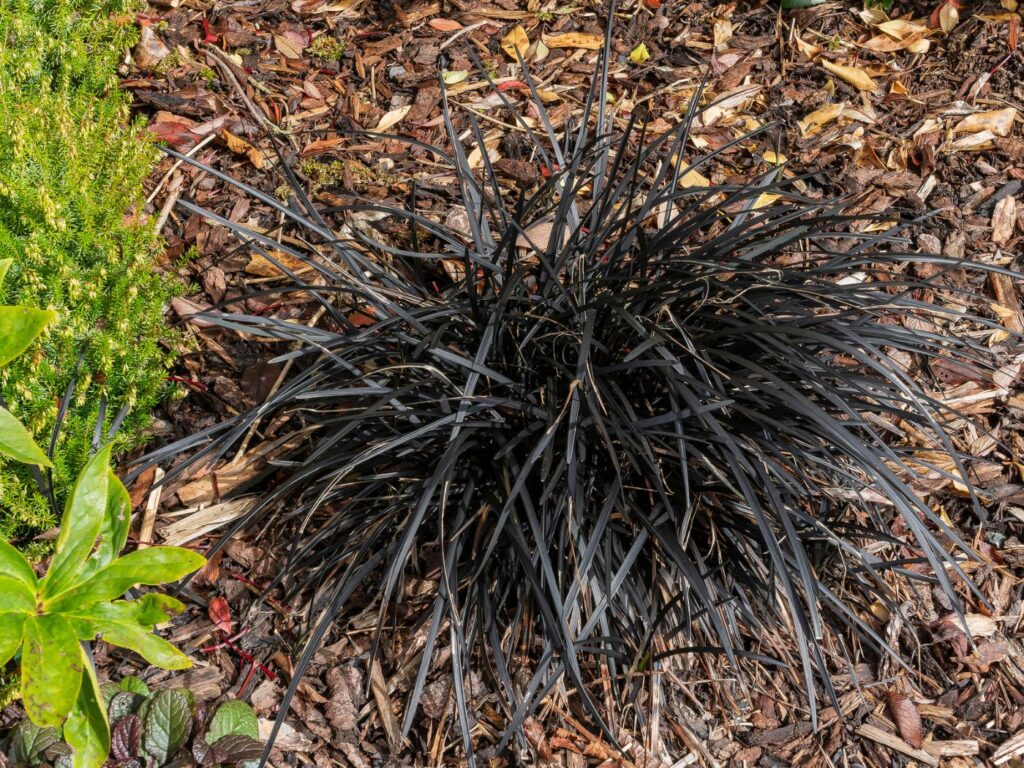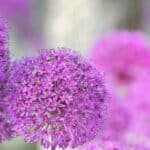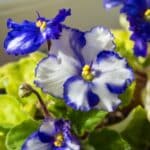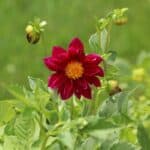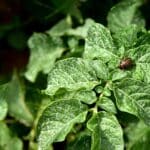Black mondo grass (Ophiopogon planiscapus nigrescens) is a popular ornamental that is often used to create showy borders around garden beds or alongside walkways.
This clump-forming grass is common in landscapes because its black leaves can accentuate some of the other plants in your garden so that they will stand out even more. It is also beloved because it is straightforward to care for since it spreads through rhizomes and doesn’t require pruning or mowing.
Black mondo grass is considered invasive in many southern states because it can swiftly spread all over gardens and become a nuisance in turf lawns and gardens. Technically, it also isn’t a grass, but it is a member of the asparagus family.
If you want to grow thick clumps of black mondo grass, then it is essential to grow it in the right location and under the right conditions. In this guide, we will share some care tips that can help these exciting foliage plants flourish.

Plant Facts
| Scientific name | Ophiopogon planiscapus ‘Nigrescens’ |
| Common names | Black mondo grass, mondo grass, black lilyturf |
| Family | Asparagaceae |
| Plant Type | Ornamental grass |
| Height and Width | 8 – 12 Inches tall, 9 – 12 inches wide |
| Origin | Native to Japan and Korea |
| Flower colors | Purple/lavender flowers and blue berries |
| Foliage color | Black or dark purple |
| Sun Exposure | Partial shade (2-6 hours of the day) |
| Soil Type & pH | Well drained moist soil that is neutral to acidic |
| Special features | Low Maintenance, evergreen, container plant, border plant for rock or water gardens |
What Does Black Mondo Grass Look Like?
Black mondo grass is pretty easy to identify because it produces tall but slender grass-like leaves that are very dark. The leaf color can vary. In cooler temperatures or shade, the leaves can appear dark green. In warmer weather and a slightly more sunny position, the leaves will become much darker and appear jet-black or purple-black.
These ornamental grasses can bloom in summer, producing showy light purple or white flowers well above the foliage. After some time, the flowers will transform into purple berries, and the seeds will also form within these berries.
Where Does Black Mondo Grass Grow?
Mondo grass is native to Japan and Korea where it naturally grows on open and forested slopes. Because of the plant’s attractive appearance, it is, however, used in many different countries across the globe as an ornamental garden feature.
How to Grow Black Mondo Grass?
Growing and caring for this ornamental grass is simple, but growing it in a suitable environment is important under appropriate conditions. Remember that this plant has a slow growth rate, and you must be patient if you want to grow lush clumps for borders or mass planting.
Here is a quick look at our black mondo grass care strategy.
Propagation
Black mondo grass can be grown from seed or propagated by dividing the clumps before replanting them.
If you are growing this plant from seeds, it is best to soak them in warm water for 24 hours before sowing them. These seeds can be sown directly in your garden soil, and it is best to sow during fall. By early spring, you should see some sprouting after about 30 – 150 days.
Rhizomes spread these plants and form dense clumps. The clumps can be divided to propagate the plant. It is best to wait until late fall, just before the first new growths appear, before digging up the rhizomes for dividing.
To divide the rhizomes, you can unearth the clumps, rinse them, and cut them into smaller sizes. These smaller portions can then be replanted and kept moist for a couple of weeks so the new roots can take.
Soil
Black lilyturf should be planted in well-draining soil because it can develop root rot in wet conditions. This plant prefers slightly acidic, hummus-rich soils with lots of organic matter. You can also plant mondo grass in loam soils, but ideally, avoiding soils that are too sandy and heavy clay soils is best
Pruning
There is no need to prune mondo grass during the year. It is a very low-maintenance plant that stays evergreen and beautiful through all four seasons. Some gardeners like to prune the plants’ dead leaves in late winter because this can boost the plants’ health and encourage some fresh new growth.
You should avoid mowing this grass or pruning it back too much because it can take months or years to recover if all the growth is cut back fully.
How to Care for Black Mondo Grass
If you take good care of this plant with its grass-like leaves then you will have a dense carpet of lush growth that can look very attractive. This evergreen perennial doesn’t require much effort at all. Here is a quick look at how to care for this plant.
Water
The grass grows best in consistently moist soil, but it shouldn’t be kept wet all the time. Regular watering will encourage healthy growth and help the plant flower better. Even though these plants prefer moist soil, they can be drought tolerant at times and should be able to survive short dry spells as long as they are not exposed to extreme heat.
Sunlight
Black lilyturf prefers partial shade positions with 2 – 6 hours of direct sunlight. In cooler environments, this plant can be grown in full sun but for drier climates, it is best to establish it where it will receive lots of afternoon shade or the leaves will become scorched.
Temperature and Humidity
This plant tolerates high humidity levels as long as it still receives good airflow from its wavy leaves. Because of its high tolerance to humidity, it is often used around water features like fish ponds.
These perennial grasses are cold-hardy but cannot tolerate freezing temperatures. They can handle a bit of light frost but can be damaged if it gets too cold.
Fertilizer
The plant prefers humus-rich soil with lots of organic matter and can survive without fertilizer if grown in rich soil. Gardeners only need to add some plant feed, balanced fertilizer, or compost to support it during its growing season.
Pests and Diseases
Mondo grass is relatively pest- and disease-free, but you can encounter some issues if not cared for properly. Here is a quick look at the most common pests and diseases to look out for with this type of plant.
Pythium Root Rot
Pythium root rot is a type of fungal rot that can occur if the soil is kept too moist. This usually results in yellow and browned leaves and your plant can die if the excess water isn’t reduced.
Snails and Slugs
Most insects and diseases tend to avoid these beautiful grasses with their purplish-black leaves. Snails and slugs can, however, be an issue because they will chew holes in the leaves. Bait lures or pesticides can treat this common issue pretty quickly.
Black Mondo Grass Companions
The best companion plants for black mondo grass are usually species with bright foliage or flower colors. This is because the dark leaves of this plant will make anything next to it stand out even more.
Some of the best plants to grow with black mondo grass include species like creeping jennies, ivy geraniums, coral bells, snow-in-the-summer flowers, Japanese sweet flags, or boxwoods.
Black Mondo Grass Landscaping Ideas
You can use black mondo grass to create exciting landscape features. This plant does well as a ground cover for taller plants and is ideal for creating striking borders or as an edging around pond edges, walkways, or garden beds.
This evergreen perennial is also an ideal plant to use in a rock garden or it can be used around water features along with other texture-rich and colorful plants.
Common Varieties and Cultivars
Black mondo grass is a variety of mondo grass (Ophiopogon japonicus). Mondo grass does have quite a few different varieties but there are only two main cultivars or varieties of the black mondo grass variety which include the following;
- ‘Kokuryu’
- ‘Nigrescens’
Conclusion
The unique leaf color of black mondo grass makes it one of the most interesting plant species to include in your garden. This specimen plant is ideal for creating all sorts of showy landscape features, and gardeners or landscapers love it because it is so easy to grow and care for.
We hope our guide makes it a little bit easier for you to take good care of your plants to grow black mondo grass that looks attractive and lush throughout the year.
Image by lenschanger/depositphotos

